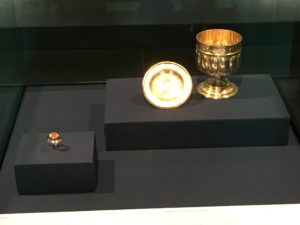
Actually, I’m writing while the gals and our new friends from Australia (we met them yesterday at lunch) are talking around me.
So, if this post is no good, you will know why. Hemingway never had to put up with such distractions.
Ann and The Wife tried to pressure me to write earlier this afternoon, but as I told them, you can’t command creativity, and I wasn’t feeling it.
Today was a good day: a good balance between touring and relaxing. Too much touring and too much listening to tour guides drone on with all the fun facts and scripted stories, it can get old after a while.
Our excursion today consisted of a 3 1/2 hour morning walking tour of Dresden. There is much to see here but it all has a wrinkle: because the city centre was reduced to rubble by allied bombing one night in February 1945, almost everything one sees has been rebuilt. However, it was rebuilt to look old by essentially copying what was destroyed in 1945. In that sense, this city is unique and a bit odd. Touring Dresden is a like watching a very good actor—there is the appearance of authenticity but you have to remind yourself it is not what it appears to be.
I’ve avoided talking too much about the Nazis and the Communists thus far because it can easily overshadow what we came here to do, and that is explore and discuss the Reformation. But today, with being in Dresden, it is really unavoidable.
If the Nazis and Communists had any one thing in common it is that they were both godless, and being godless they were unrestrained by any understanding of accountability to God. We heard the horror stories in Prague of the Nazi beast, Reinhard Heydrich, and thereafter the Communists. Here, in Dresden, the Soviets and their local Communist puppets gave the people a police state and joke of an economy. Our tour guide told us of one her memories under Communism was as a young mother standing in line for an hour to have the privilege of purchasing six bananas and then cutting them up into pieces to try to make them last until the next opportunity to buy fruit.
There was a discussion today among The Wife and I as to whether the Nazis and Communists were the result of a curse on a continent that had largely abandoned the true king, Jesus. Only the Lord knows, but no one in Europe thinks the Nazis or Communism was a blessing, that is for sure.
The Reformation took hold in Dresden in 1539, and is commemorated in the town square with the Church of Our Lady, and a large statute of Martin Luther. Ann who can sniff popery from 1,000 meters, had concerns the church was actually a Catholic Church, and she was right (although the “Our Lady” is usually a pretty good clue).
This church’s predecessor was Catholic and in the Reformation became a Protestant church. The Protestants decided to keep the name of the church. The church that succeeded it was destroyed during the Dresden bombing in World War II and the ruble left as a war memorial until after reunification when it was rebuilt. It was completed in 2005.

But Augustus built big buildings that stood the test of time (but not Allied bombs) and so he is remembered. It is always good to remember that insofar as the world is concerned competence trumps righteousness.
As we toured the Green Vault our tour guide walked right past a room with a special Martin Luther exhibit (there for the 500th anniversary of the Reformation), saying nothing. The Wife, though, always aware, spotted the exhibit, and inside she, Ann, and I struck gold: Martin Luther’s signet ring and a cup that was given him by a friend.
If Luther was here he would probably think it silly that we would get excited about his ring and his cup. He would tell us to focus on Jesus, and he would be right of course. But we are on what Ann has dubbed “a Luther quest,” and his ring and cup foreshadow what is to come.
Stay tuned. GS
